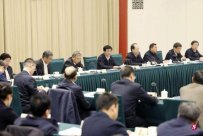The Chinese government has reportedly restricted infrastructure construction projects in high -risk areas of debt to restrict the risk of local debt risks that are still high.Analysis pointed out that how to reduce new debts while not impacting economic activities is the two difficulties in the official solution.
Reuters on Friday (January 19) quoted people familiar with the matter and said that the State Council of China issued a notice to local governments and state -owned banks in recent weeks, requiring 12 debt issues such as Liaoning, Jilin, Guizhou, Yunnan, Tianjin, and Chongqing.The provincial and municipalities have delayed or stopped the construction of projects with less than half of the current investment. For projects with an investment rate of more than 50 %, the scale of investment must also be compressed.It is known that three autonomous regions are restricted.
This type of project includes highways, airports and expansion and urban rail transit projects, and projects approved by central governments such as economic affordable housing are not affected.
Sources disclosed that the above provinces and regions and municipalities are required to reduce their debt risks to low and medium levels. Once the standards are met, the China National Development and Reform Commission will seek new investment for the State Council for approval.However, the notice did not explain how to measure the degree of debt reduction.
It was reported in October last year that The State Council has limited these 12 regionsIssuing new debt and new projects .This year's management and control has been further, which also reflects that the status of local liabilities has not yet improved significantly.
During the three -year crown disease epidemic, multiple factors such as increased epidemic expenditure, decrease in return on investment, and decreased land income have increased China's local fiscal pressure, and also exacerbated the market's concerns about the upgrading of local debt risks. international rating agency Moody last month will rating China Sovereign Credit Credit Rating rating last month.The prospects are adjusted from "stability" to "negative", and warnings are issued against local debt and real estate risks.
According to the data of the Ministry of Finance of China, the scale of government debt in 2022 was 61 trillion yuan (RMB, the same below, the same, S $ 11.5 trillion), of which local government debt was 35.1 trillion yuan, but this did not include "The hidden debt of urban investment bonds.According to the International Monetary Fund (IMF), the total hidden debt at the end of 2022 was as high as 66 trillion yuan.
Since October last year, Special financing bonds in many places , replace hidden debt into a low -risk debt.At present, the Special Resertoral Financial Bonds Among them, Guizhou, Tianjin, Yunnan, Hunan and other places have issued more than 100 billion yuan.
At the same time, The central government of the Chinese Central Government added 1 trillion yuan last year last yearYuan Special Treasury Bond , so as to boost the economy and reduce local pressure.Wang Tao, the chief Chinese economist of UBS (UBS), predicts that the central government may issue another 1 trillion yuan special Treasury bonds this year, and increase the local special recycling bonds to 2 trillion to 3 trillion yuan to expand the scale of bonds.
The CPC Central Economic Work Conference held last month will be. Resolving local debt risks , requiring require"Coordinate the resolution and stable development of local debt risks."
Lu Xi, assistant professor of the School of Public Policy of the National University of Singapore National University, analyzed the United Zaobao interview that infrastructure projects such as airports, highways and subway have been saturated or even built.The project is because they can drive a large number of subsequent engineering packages to create employment and drive the economy.
Lu Xi believes that stop or postponed large infrastructure projects can help prevent new debts from forming, but it will bring a lot of blow to the motivation for economic activities and officials to develop economy.During the buffer period that has been won through debt replacement, if the market cannot see a new development model, it is difficult to fundamentally change the problem of lack of economic confidence in China.




